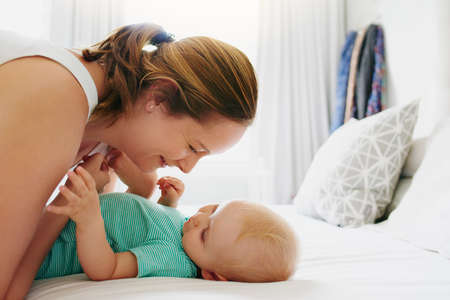1. Why Proper Baby Monitor Placement Matters
Choosing the right spot for your baby monitor is more important than you might think. A well-placed monitor ensures your little one’s safety, provides clear audio, and gives you the best possible view of their crib or play area. Let’s explore why proper placement matters and what you should consider.
Safety First: Keeping Cords and Cameras Out of Reach
One of the biggest concerns with baby monitors is safety. Monitors with cords can pose a strangulation risk if placed too close to the crib. To ensure a safe setup:
- Keep all cords at least 3 feet away from the crib.
- If mounting on the wall, secure cords with cord covers or cable management clips.
- Avoid placing monitors where they could accidentally fall into the crib.
Clear Audio: Reducing Background Noise
A good baby monitor setup should allow you to hear your baby clearly without interference from background noise. Here are some tips for better audio:
- Avoid placing the monitor near loud electronics like TVs, fans, or air purifiers.
- If using a two-way audio monitor, test the placement to prevent echo or feedback.
- Position the microphone in a way that captures sound directly from your baby’s sleeping area.
The Best View: Finding the Right Angle
Your monitor should provide a clear and unobstructed view of your baby. Depending on the type of camera you have, here are some ideal placement options:
| Monitor Type | Best Placement |
|---|---|
| Wall-mounted cameras | Position high on the wall angled downward for a full crib view. |
| Shelf or dresser placement | Aim for a stable surface at least 3-6 feet away from the crib. |
| Cot-attached monitors | Avoid direct attachment to avoid risks; use a nearby shelf instead. |
Avoiding Blind Spots
You don’t want to check your monitor and realize half of your baby’s crib is out of view! Before finalizing placement:
- Test different angles during both daytime and nighttime lighting conditions.
- If your monitor has pan-and-tilt features, adjust it to cover more space.
- Avoid placing objects in front of the camera that could block the view.
2. Ideal Spots to Place Your Baby Monitor
Finding the perfect spot for your baby monitor is essential to ensure you have a clear view and sound of your little one. Here are some of the best placement options:
Wall-Mounted Placement
Mounting the baby monitor on the wall is a great way to get a bird’s-eye view of the crib while keeping it out of reach. Use a secure bracket or adhesive mount to keep it stable.
Pros:
- Provides a wide-angle view
- Keeps monitor cords away from the baby
- Saves space in smaller nurseries
Cons:
- Might require drilling into the wall
- Difficult to adjust once installed
Shelf Placement
If you prefer not to mount anything on the wall, placing the baby monitor on a shelf is a good alternative. Make sure its positioned at an angle that allows a clear view of the crib.
| Pros | Cons |
|---|---|
| Easy to adjust or move | Might be knocked over if not secured |
| No wall drilling needed | Cords may still be within reach if not managed properly |
Crib-Side Placement
This option involves placing the baby monitor on a dresser or nightstand near the crib. It provides an up-close view but should be positioned safely.
Safety Tips:
- Ensure cords are tucked away and out of reach
- Avoid placing the monitor too close to avoid interference with sleep
- Select a sturdy surface to prevent tipping over

3. Common Placement Mistakes to Avoid
Find out the most frequent mistakes parents make when positioning their baby monitors and how to fix them for optimal performance.
Placing the Monitor Too Far Away
If the monitor is too far from your baby, you may not get a clear view or good sound quality. This can make it difficult to monitor your baby effectively.
How to Fix It:
- Position the monitor within 6 to 10 feet of the crib for a clear view and audio.
- Use a wall mount or shelf to get a better angle without placing it too close.
Mounting the Monitor Too Close
While its important to have a good view, placing the monitor too close can pose safety hazards, such as strangulation risks from cords.
How to Fix It:
- Ensure the monitor is at least 3 feet away from the crib to prevent any safety issues.
- If using a corded monitor, secure the wires out of reach with cable management solutions.
Aiming the Camera Incorrectly
An incorrect camera angle can result in blind spots, making it harder to see your baby properly.
How to Fix It:
- Aim the camera slightly downward for a full view of the crib.
- Avoid extreme side angles that may only show part of your baby’s sleep space.
Ignoring Night Vision Quality
If your monitor has poor night vision or is placed incorrectly, you might struggle to see your baby clearly in low light conditions.
How to Fix It:
- Test night vision mode before finalizing placement.
- Avoid placing the monitor near bright light sources that could interfere with infrared capabilities.
Selecting an Unstable Surface
A baby monitor placed on an unstable surface can fall and break or change positions unexpectedly.
How to Fix It:
- Select a secure shelf, mount, or table that will keep the monitor steady.
- Avoid placing it on soft or uneven surfaces like pillows or plush furniture.
Mistakes and Solutions at a Glance
| Mistake | Solution |
|---|---|
| Placing the monitor too far away | Keep it within 6-10 feet of the crib |
| Mounting the monitor too close | Maintain at least 3 feet of distance from crib |
| Aiming the camera incorrectly | Tilt slightly downward for full crib visibility |
| Poor night vision setup | Avoid bright lights interfering with infrared mode |
| Selecting an unstable surface | Use a secure, flat surface for stability |
Avoiding these common mistakes will help you get the best performance from your baby monitor while ensuring your little one stays safe and visible at all times.
4. Safety Considerations for Baby Monitor Setup
Ensuring your baby’s safety is the top priority when setting up a baby monitor. Proper placement helps prevent accidents while still giving you a clear view and good sound quality. Follow these best practices to keep your little one safe.
Wire Management: Keep Cords Out of Reach
Baby monitor cords can pose a serious strangulation hazard if placed too close to the crib. Always keep wires at least 3 feet away from the crib, playpen, or any area where your baby can reach them.
| Wire Safety Tips | Why It Matters |
|---|---|
| Use cord covers or wire concealers | Prevents babies from grabbing or pulling on cords |
| Mount the monitor high up and out of reach | Keeps wires far from little hands |
| Avoid placing the monitor on furniture near the crib | Cords can dangle and become a risk if pulled down |
| Choose a wireless monitor if possible | No cords mean no risk of entanglement |
Distance from the Crib: Finding the Right Balance
The baby monitor should be placed close enough to capture clear video and audio but far enough to avoid potential hazards. A good rule of thumb is to position it 3–6 feet away from the crib while angling it downward for the best view.
The Best Placement Options:
- A wall-mounted camera: Keeps it secure and offers an overhead view.
- A shelf across the room: Provides a safe distance while maintaining visibility.
- A corner mount: Gives a wide-angle view without being intrusive.
Avoid Hazardous Placements
Certain placements can pose risks that may not be obvious at first. Be mindful of where you put the monitor to prevent accidents.
Avoid These Dangerous Locations:
- Inside or on the crib: Your baby might grab it, knock it over, or get tangled in cords.
- Narrow shelves that aren’t secured: The monitor could tip over and fall into the crib.
- Piles of blankets or soft surfaces: This can block ventilation and cause overheating.
- Toy bins or play areas: Curious little hands might pull it down.
A safe setup ensures both security and peace of mind. By managing wires properly, keeping a safe distance, and avoiding risky placements, you can create a safer environment for your baby while still keeping an eye on them effectively.
5. Tips for Getting the Best View and Sound
Discover practical tips to fine-tune your baby monitors position for clear visibility and optimal sound quality, day or night. Proper placement ensures you can see and hear your little one without interference or blind spots.
Find the Ideal Camera Angle
Positioning the camera at the right angle is key to getting a full view of your babys crib. A slightly downward angle from a high vantage point works best.
Best Camera Angles for Different Setups
| Placement | Recommended Angle |
|---|---|
| Wall-mounted above crib | Slightly downward (45-degree angle) |
| Shelf near crib | Straight-on or slight downward tilt |
| Dresser across the room | Zoom-in with a wide-angle view |
Avoid Audio Interference
To ensure clear sound, place the monitor away from devices like Wi-Fi routers, smartphones, and other electronics that may cause interference.
Tips for Better Audio Quality
- Keep the monitor at least 3 feet away from other electronics.
- Avoid placing it near windows where outside noise can interfere.
- If using a two-way audio feature, test it to prevent feedback loops.
Optimize Night Vision Clarity
If your baby monitor has night vision, proper placement is essential for a clear image. Avoid direct light sources that could wash out the picture.
Night Vision Placement Tips
- Avoid pointing the camera directly at lamps or windows.
- If the image appears too bright or too dark, adjust positioning slightly.
- Tidy up reflective surfaces that might cause glare in night mode.
Troubleshooting Common Issues
If youre experiencing blurry video or distorted sound, making small adjustments can help improve performance.
Quick Fixes for Common Problems
| Issue | Solution |
|---|---|
| Poor video quality | Clean the camera lens and adjust lighting conditions. |
| Noisy or unclear audio | Avoid placing the monitor too close to fans or white noise machines. |
| Narrow field of view | Use a wide-angle lens attachment if available. |

